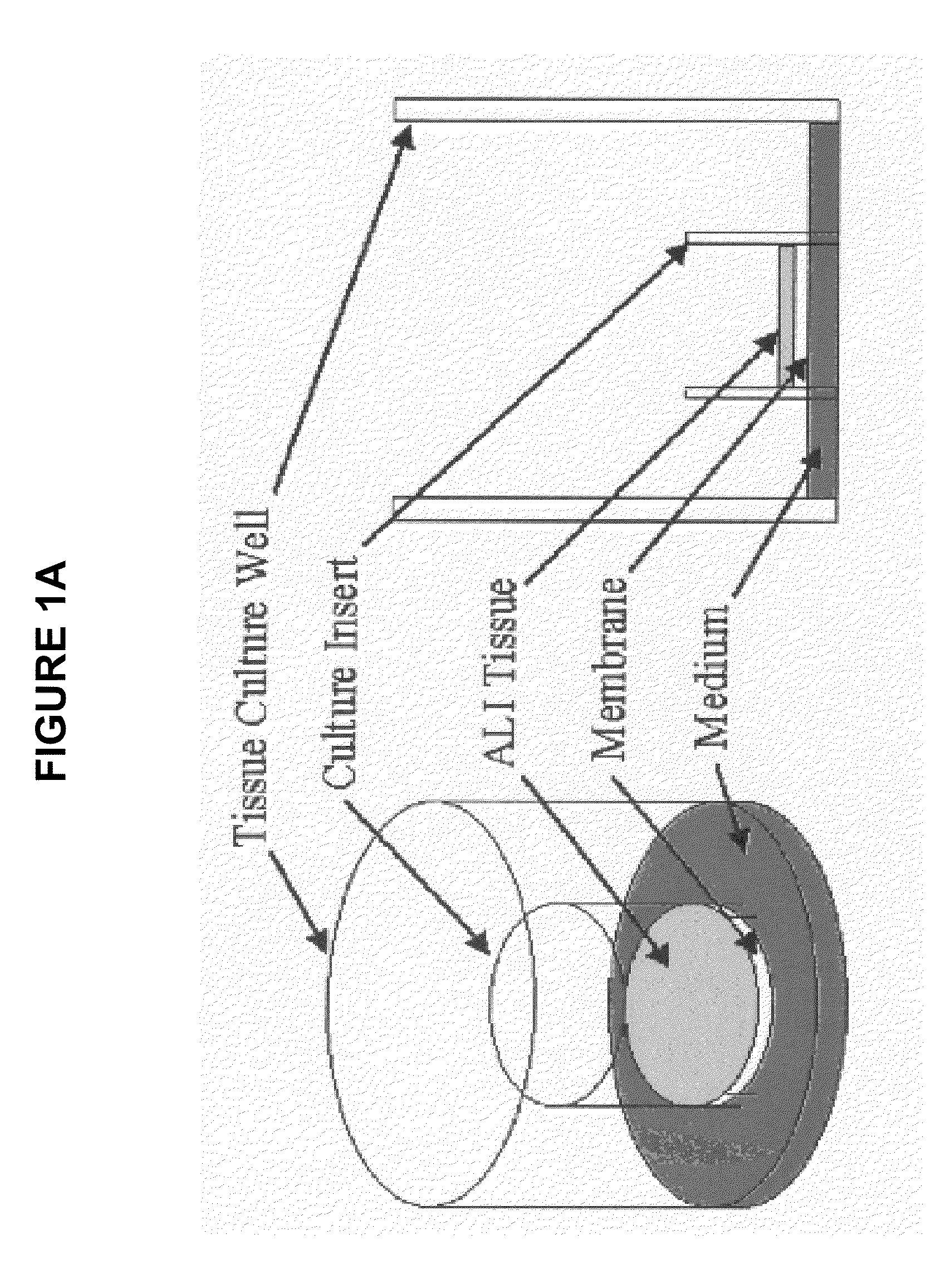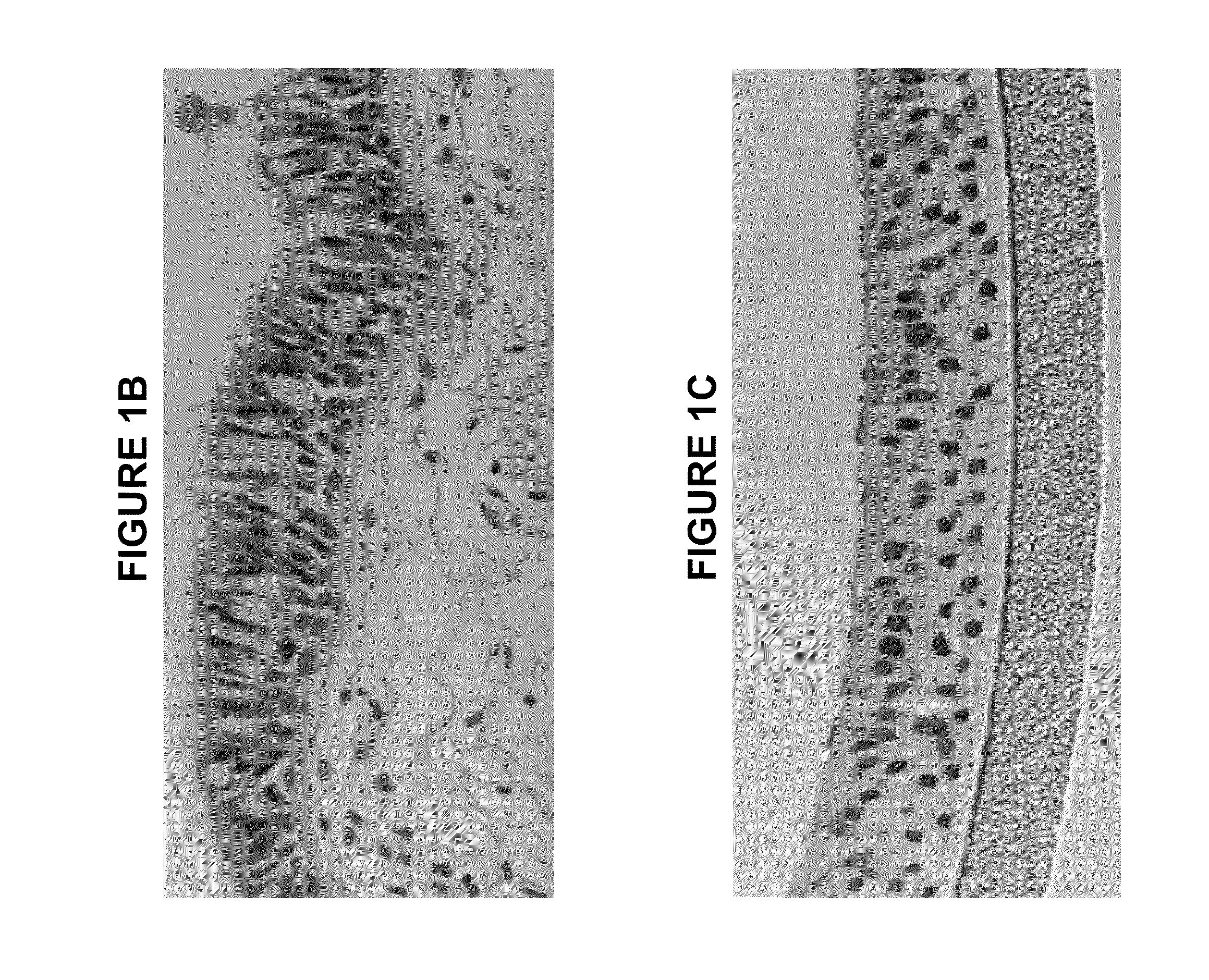Method for Predicting Respiratory Toxicity of Compounds
a toxicity prediction and respiratory technology, applied in the field of in vitro, can solve the problems of high probability of false negative and false positive data, high cost and time-consuming of animal models used to assess the toxicity of substances, and difficult to match in vitro data with in vivo toxicity,
- Summary
- Abstract
- Description
- Claims
- Application Information
AI Technical Summary
Benefits of technology
Problems solved by technology
Method used
Image
Examples
example 1
[0063]Bleomycin is a glycosylated peptide antibiotic originally isolated from the fungus Streptomyces verticillus. It is commonly used to treat many types of cancer and is well known for its induction of a potentially fatal respiratory condition called bleomycin-induced pneumonitis or BIP. Bleomycin is known to induce IL-1, IL-6, IL-8, TNF-α and TGF-β expression in the lungs of mice in vivo (Cavarra et al., 2004, Chaudhary et al., 2006, Piguet et al., 1989, Zhang et al., 1997, Karmiol et al., 1993, Micallef et al., 1992, and Phan and Kunkel, 1992). Bleomycin also induces oxidative stress in the pulmonary epithelia of mice, which is known to be a crucial component of its toxicity (Manoury et al., 2005). Extended exposure of the human lung cells to bleomycin can lead to activation of fibroblasts via cytokine signaling, which may eventually lead to fibrosis (Moseley et al., 1986, Sugerman et al., 1985 and Schmidt et al., 1982). Although the exact mechanism of in vivo cytotoxic...
example 2
[0069]Although the element cadmium is readily used in the manufacture of batteries, its use in other industries (solder, plastics coatings, metal electroplating etc.) has readily decreased over the years due to its toxicity. Cadmium is known to have many serious effects on health with a half life of 15-20 years once ingested (Jarup et al., 1998 and Jin et al., 1998). Today, the primary route of cadmium exposure is through cigarette smoking (Nandi et al., 1969, Martin et al., 2009), and cadmium is well known for its toxic effects on the lung tissue (Patwardhan et al., 1975, Han et al., 2007 and Kundu et al., 2007). In rats, administration of cadmium induced pulmonary inflammation and induced expression and subsequent increase in circulating levels of IL-6 and TNF-α (Kataranovski et al., 1998). Cadmium exposure has also been shown to induce pulmonary fibrosis with TGF-β co-administration in rats and mice (Lin et al., 1998 and Kasper et al., 2004). In humans, the mechan...
example 3
[0074]Beryllium has considerable value in modern industry, with uses in aerospace and nuclear power industries. It is a common component in automobiles, computers and other electronics. Inhaled beryllium particles can cause chemical pneumonitis (Eisenbud et al., 1948), also called acute beryllium pneumonitis. As long as patients avoid further exposure to beryllium, they usually recover, although some cases can progress to chronic beryllium disease or CBD (Sprince et al., 1976). Fortunately, standard practices put into place by the Atomic Energy Commission in 1949 (Eisenbud, 1982) have greatly reduced beryllium exposure. Since acute beryllium disease has virtually disappeared due to these measures, research has focused on the immunology of CBD. Dobis et al. analyzed patients with either CBD or beryllium sensitization and concluded that beryllium can mediate a thiol imbalance leading to oxidative stress which may play a role in the pathology of the disease. However, this work...
PUM
| Property | Measurement | Unit |
|---|---|---|
| Concentration | aaaaa | aaaaa |
| Structure | aaaaa | aaaaa |
| Stress optical coefficient | aaaaa | aaaaa |
Abstract
Description
Claims
Application Information
 Login to View More
Login to View More - R&D
- Intellectual Property
- Life Sciences
- Materials
- Tech Scout
- Unparalleled Data Quality
- Higher Quality Content
- 60% Fewer Hallucinations
Browse by: Latest US Patents, China's latest patents, Technical Efficacy Thesaurus, Application Domain, Technology Topic, Popular Technical Reports.
© 2025 PatSnap. All rights reserved.Legal|Privacy policy|Modern Slavery Act Transparency Statement|Sitemap|About US| Contact US: help@patsnap.com



